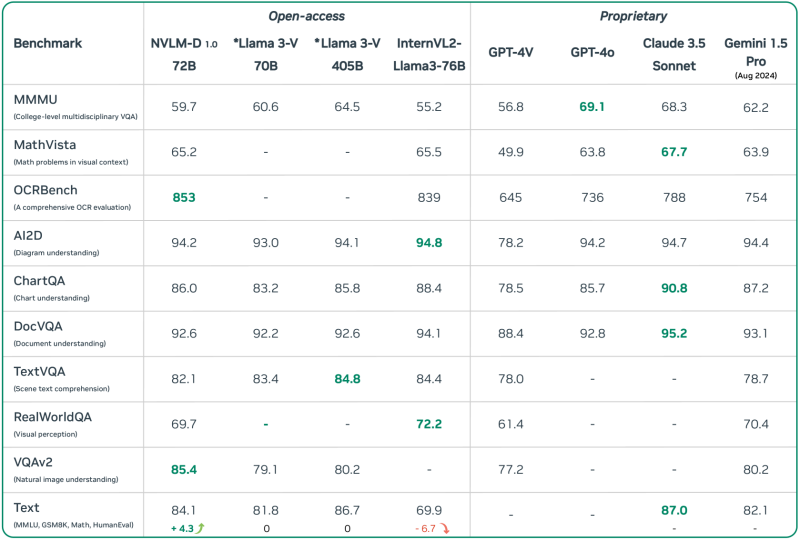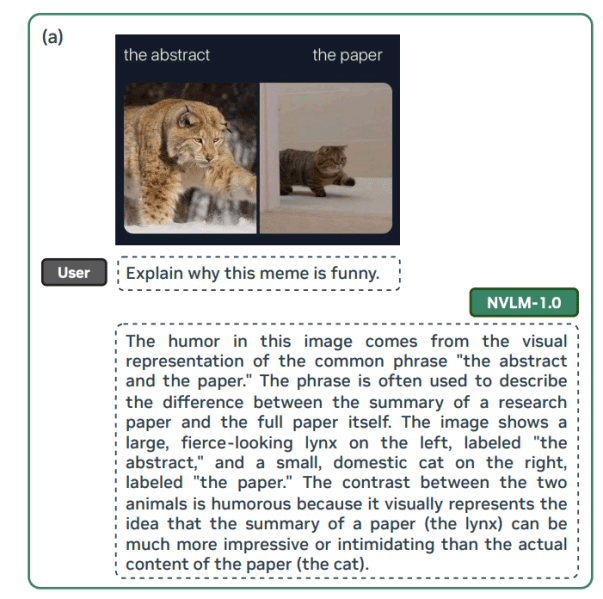Nvidia just dropped a bombshell: Its new AI model is open, massive, and ready to rival GPT-4
Join our daily and weekly newsletters for the latest updates and exclusive content on industry-leading AI coverage. Learn More
Nvidia has released a powerful open-source artificial intelligence model that competes with proprietary systems from industry leaders like OpenAI and Google.
The company’s new NVLM 1.0 family of large multimodal language models, led by the 72 billion parameter NVLM-D-72B, demonstrates exceptional performance across vision and language tasks while also enhancing text-only capabilities.
“We introduce NVLM 1.0, a family of frontier-class multimodal large language models that achieve state-of-the-art results on vision-language tasks, rivaling the leading proprietary models (e.g., GPT-4o) and open-access models,” the researchers explain in their paper.
By making the model weights publicly available and promising to release the training code, Nvidia breaks from the trend of keeping advanced AI systems closed. This decision grants researchers and developers unprecedented access to cutting-edge technology.

NVLM-D-72B: A versatile performer in visual and textual tasks
The NVLM-D-72B model shows impressive adaptability in processing complex visual and textual inputs. Researchers provided examples that highlight the model’s ability to interpret memes, analyze images, and solve mathematical problems step-by-step.
Notably, NVLM-D-72B improves its performance on text-only tasks after multimodal training. While many similar models see a decline in text performance, NVLM-D-72B increased its accuracy by an average of 4.3 points across key text benchmarks.
“Our NVLM-D-1.0-72B demonstrates significant improvements over its text backbone on text-only math and coding benchmarks,” the researchers note, emphasizing a key advantage of their approach.

AI researchers respond to Nvidia’s open-source initiative
The AI community has reacted positively to the release. One AI researcher commenting on social media, observed, “Wow! Nvidia just published a 72B model with is ~on par with llama 3.1 405B in math and coding evals and also has vision ?”
Nvidia’s decision to make such a powerful model openly available could accelerate AI research and development across the field. By providing access to a model that rivals proprietary systems from well-funded tech companies, Nvidia may enable smaller organizations and independent researchers to contribute more significantly to AI advancements.
The NVLM project also introduces innovative architectural designs, including a hybrid approach that combines different multimodal processing techniques. This development could shape the direction of future research in the field.
NVLM 1.0: A new chapter in open-source AI development
Nvidia’s release of NVLM 1.0 marks a pivotal moment in AI development. By open-sourcing a model that rivals proprietary giants, Nvidia isn’t just sharing code—it’s challenging the very structure of the AI industry.
This move could spark a chain reaction. Other tech leaders may feel pressure to open their research, potentially accelerating AI progress across the board. It also levels the playing field, allowing smaller teams and researchers to innovate with tools once reserved for tech giants.
However, NVLM 1.0’s release isn’t without risks. As powerful AI becomes more accessible, concerns about misuse and ethical implications will likely grow. The AI community now faces the complex task of promoting innovation while establishing guardrails for responsible use.
Nvidia’s decision also raises questions about the future of AI business models. If state-of-the-art models become freely available, companies may need to rethink how they create value and maintain competitive edges in AI.
The true impact of NVLM 1.0 will unfold in the coming months and years. It could usher in an era of unprecedented collaboration and innovation in AI. Or, it might force a reckoning with the unintended consequences of widely available, advanced AI.
One thing is certain: Nvidia has fired a shot across the bow of the AI industry. The question now is not if the landscape will change, but how dramatically—and who will adapt fast enough to thrive in this new world of open AI.
Source link


